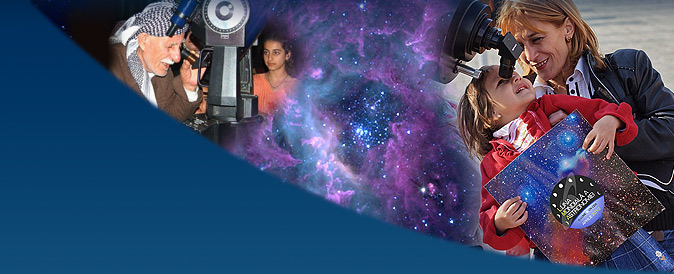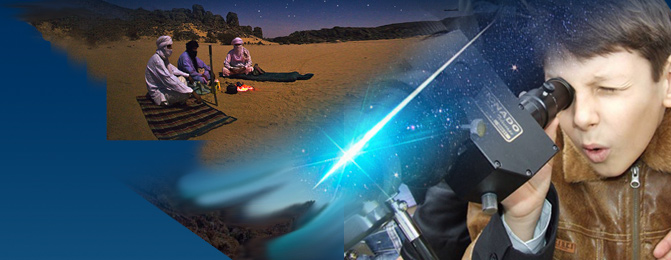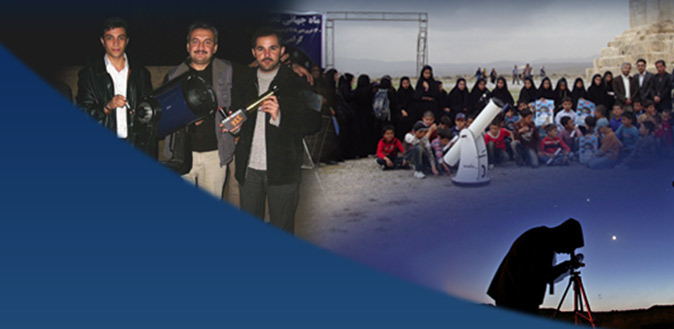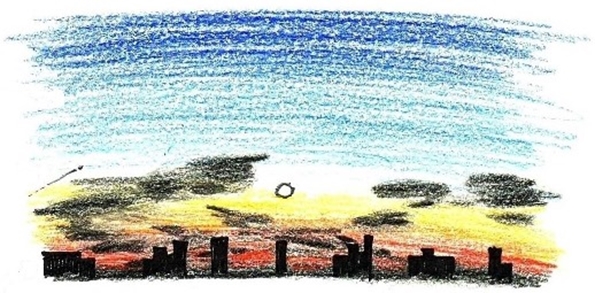Lunar Day
April 2
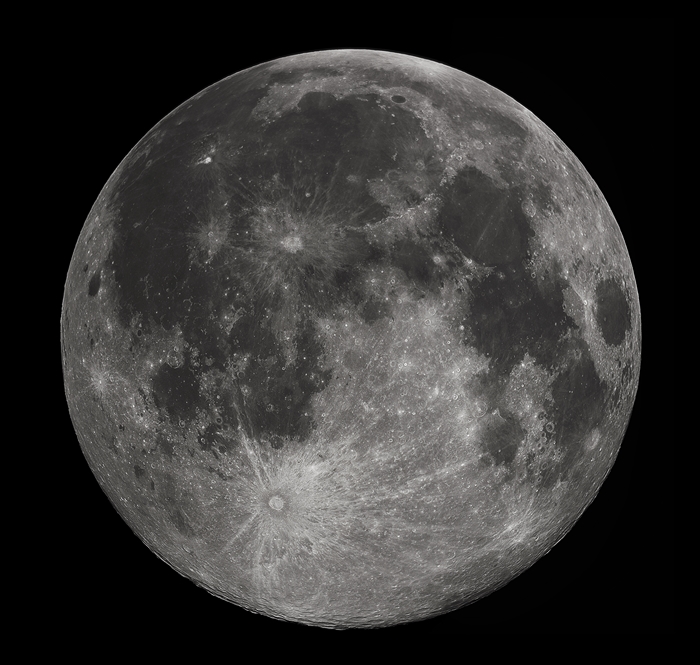 The Moon
The Moon
credit: Gregory H. Revera
Two children act as the Moon and the Earth. By holding hands and spinning around they mimic the tidal locking of the Moon. They note that the Moon always keeps the same face towards Earth.
Evening Sky Watching for Students
Nursery (or Kindergarten or Preschool) students enjoy seeing the evening sky with the teacher from the playground or through a big window (indoor). This is especially relevant for students who stay for extra-hour care. During late evening hours, some students feel a little lonely waiting for their parents, but they have a wonderful natural treasure: the evening sky. By observing the evening sky with the naked eye, they will notice many colours, changing colours, the first star, the subtle colours of stars, twinkling stars, and the movement of stars. Nursery teachers who think they are not science-oriented will also gain guidance skills of introducing science to students. This activity is also useful for primary school students, especially younger-grade students.
Astronomy as Community: Easing Loneliness
By Jessica Santascoy
Astronomy is a gateway for learning science, says founder and president of Astronomers Without Borders, Mike Simmons. Many people agree and there’s data to prove it. Astronomy can also help remedy an issue you might not have thought about: loneliness. Loneliness is an increasing worldwide phenomena, affecting approximately 30% of us in the United States alone.
The effects of loneliness are profound. By some estimates, loneliness is as lethal as smoking 15 cigarettes in a day. Loneliness increases vulnerability to depression, anxiety, dementia and cardiovascular disease. It often leads to reduced task performance, impaired reasoning and limited creativity.
Astronomers Without Borders was founded on the knowledge that we are one people, one sky. Inclusion and a sense of community are embedded in the phrase. We immediately make it clear that you are welcome, no matter who you are or where you are located. Our programs reflect our ideals and the reality that we all share the same sky.
Global Astronomy Month offers programs every April that encourage people to look up together. Shared experience helps people feel part of something - and feeling like we’re part of something helps ease loneliness.
Our programming is truly participatory. You can go online for a panel discussion, or view the sky through a virtual telescope. You can write poetry or make art and participate in our contests. There are programs for everyone, at any age, and almost everyone in any part of the world can join. If you mostly work online, attending an in-person event is a great way to help you stay connected to people. You might even be inspired to join an astronomy club.

Astronomy as Community: Malaysia Sabah Stargazers and AWB President Mike Simmons
We have over 160 events, including star parties, during Global Astronomy Month. I’d like to share one of our programs that demonstrates the sense of connection you can get through our programs — even after GAM.
Italian astronomer Gianluca Masi has been taking us on virtual sky tours for the last 8 years. This year he was joined by artist Bettina Forget, who pointed out features of the moon that are named after women. The follow-up was an online moon sketching workshop, in which people carefully observe and learn more about the moon by drawing it. You can learn how to sketch the moon even if you couldn’t make it to the live workshop, because the event, like most of our events, is recorded.

Gianluca and Bettina take you for a walk on the moon
By pairing art and science we are acknowledging that different types of interests can be merged, and that artistic interests can be a motivation for learning more about science. Plus, it’s fun to take a tour of important women of history while looking at the moon!

Our Sketching the Moon workshop is available 24/7
Looking up with a community reminds us that we truly are one people, one sky. When we are alone and look up, having experienced one of AWB’s programs can bring back a memory of connection.
We look forward to seeing you, hearing from you, and looking up with you next year for GAM2019!
Help us build hope and inspiration through astronomy!
|
Jessica Santascoy is the GAM2018 Coordinator. She has an extensive background in outreach. She was the astronomy outreach coordinator at the Astronomical Society of the Pacific for the NASA Night Sky Network. She and her team at the AstroSociety earned a NASA Group Achievement Award. Photo credit: Scott Roberts, Explore Scientific
|
 |
Watch the Sketching the Moon workshop
Special thanks to our sponsors: Celestron, SkyWatchers and SouthernStars
Chasing New Horizons, All the Way to Pluto
By Alan Stern
I’m a planetary scientist who has specialized in the study of our outer solar system, particularly Pluto, other small planets out there, comets, and the Kuiper Belt. I’ve had the good fortune to be involved in a lot of space mission teams in my career—29 in total, from suborbital sounding rockets, to Shuttle experiments, to ESA and NASA planetary missions. Of the 29 missions I’ve been involved in, I’ve been Principal Investigator of the entire mission or an instrument on the mission on about half. Of those, my favorite, and the one that is probably best known, is NASA’s New Horizons mission that made the first exploration of Pluto, in 2015.
The New Horizons project was a long time in the making. It took 12 years of study and advisory committee politics just to bring it to a competition among teams who wanted to build and fly the mission. Our team, named New Horizons, won that competition in late 2001. Then we entered a breakneck 4-year effort to design, build, and test our spacecraft and get it launched in January of 2006 for the last chance Jupiter gravity assist trajectory to Pluto of that decade. New Horizon then flew at the incredible speed of over 1,000,000 kilometers per day for nine and a half years, 24x7, to reach Pluto (3 billion miles from Earth!) in the summer of 2015.
Nothing like it had occurred in a generation—the raw exploration of new worlds unparalleled since NASA’s Voyager missions to Uranus and Neptune in the late 1980s. And nothing quite like it is planned to happen ever again. The images that New Horizons sent back to Earth graced the front pages of hundreds newspapers and magazines seen on all 7 continents, and NASA’s website for the mission received more than 2 billion hits in the days surrounding the flyby.
Over 2,500 men and women worked to make New Horizons happen, and it was the highest privilege of my career to lead that team to make the farthest exploration of any world in history. But even better was the scientific wonderland that we discovered Pluto to be—a world of diverse and ongoing geologic activity; a world with a complex atmosphere and climate; a world with five moons—each fascinating in their own right; and now the first explored of all the many small planets of the Kuiper Belt.
The story of how New Horizons came to be—the good, the bad, and even the ugly, along with both our successes and our setbacks along the way, as well as the scientific results we obtained and the massive public reaction to the exploration of Pluto, are now chronicled in a new book called Chasing New Horizons (Picador Press). I coauthored Chasing New Horizons with planetary scientist and award winning writer David Grinspoon.
Chasing New Horizons is the story of the men and women behind this amazing mission: of our decades-long commitment to this exploration; of the political fights within and outside of NASA; of the amazing human ingenuity it took to design, build, and fly the mission; and of the plans for New Horizons’ next encounter, with an ancient Kuiper Belt Object 1 billion miles past Pluto, set for January 1st, 2019.
You can learn more about Chasing New Horizons at http://read.macmillan.com/lp/chasing-new-horizons-by-alan-stern-and-david-grinspoon/. It will be published on May 1st, and I hope you’ll pick one up to learn the first hand, inside story of this amazing exploration and the story behind it.

|
Alan Stern is a planetary scientist, aerospace engineer, and author. Formerly, he headed NASA’s program of all Earth and space science missions and research.
|
 |

